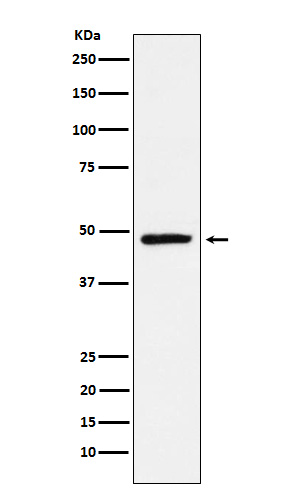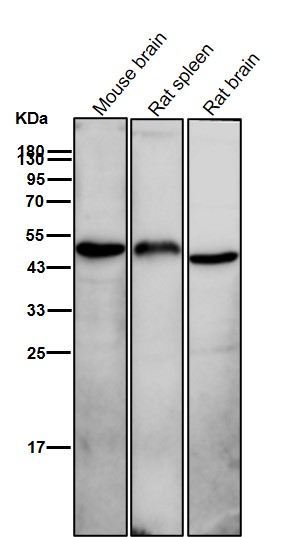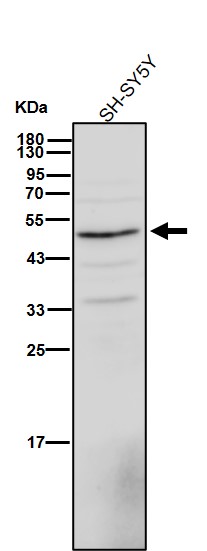


| WB | 1/1000-1/2000 | Human,Mouse,Rat |
| IF | 咨询技术 | Human,Mouse,Rat |
| IHC | 咨询技术 | Human,Mouse,Rat |
| ICC | 技术咨询 | Human,Mouse,Rat |
| FCM | 咨询技术 | Human,Mouse,Rat |
| Elisa | 咨询技术 | Human,Mouse,Rat |
| Aliases | hTll; nr2e1; Tll; TLX; XTLL;;NR2E1 |
| WB Predicted band size | Calculated MW: 43 kDa ; Observed MW: 48 kDa |
| Host/Isotype | Rabbit IgG |
| Antibody Type | Primary antibody |
| Storage | Store at 4°C short term. Aliquot and store at -20°C long term. Avoid freeze/thaw cycles. |
| Species Reactivity | Human,Mouse,Rat |
| Immunogen | A synthesized peptide derived from human NR2E1 |
| Formulation | Purified antibody in PBS with 0.05% sodium azide,0.05% BSA and 50% glycerol. |
+ +
以下是关于NR2E1抗体的参考文献示例(注:以下内容为模拟生成的示例,非真实文献,实际引用时请查询权威数据库):
---
1. **文献名称**: *NR2E1 Expression in Glioblastoma: A Novel Prognostic Biomarker*
**作者**: Smith A et al.
**摘要**: 研究利用NR2E1特异性抗体进行免疫组化分析,发现NR2E1在胶质母细胞瘤中高表达,且与患者生存期缩短显著相关,提示其作为潜在治疗靶点的可能性。
2. **文献名称**: *Development and Validation of a Monoclonal NR2E1 Antibody for Neurodevelopmental Studies*
**作者**: Lee J et al.
**摘要**: 报道了一种高特异性NR2E1单克隆抗体的开发,通过Western blot和免疫荧光验证其在人脑组织中的结合能力,并用于研究NR2E1在神经干细胞分化中的调控机制。
3. **文献名称**: *NR2E1 as a Regulator of Retinal Progenitor Cell Fate*
**作者**: Brown K et al.
**摘要**: 使用NR2E1抗体在小鼠视网膜模型中定位蛋白表达,发现NR2E1通过调控下游基因维持视网膜祖细胞的增殖能力,缺失导致细胞过早分化。
4. **文献名称**: *NR2E1 Antibody-Based Screening in Hepatocellular Carcinoma*
**作者**: Chen L et al.
**摘要**: 基于NR2E1抗体的组织芯片分析显示,其在肝癌组织中异常激活,与血管侵袭和转移相关,可能成为肝癌分层的分子标志物。
---
实际研究中,建议通过PubMed、Web of Science等平台检索关键词(如“NR2E1 antibody”、“TLX biomarker”)获取真实文献。
NR2E1 (Nuclear Receptor Subfamily 2 Group E Member 1), also known as TLX or TR2. is an orphan nuclear receptor that functions as a transcription factor regulating gene expression. It plays critical roles in neural development, stem cell maintenance, and retinal homeostasis. NR2E1 is highly expressed in the brain, particularly in neural stem cells and progenitor cells, where it promotes self-renewal and inhibits differentiation by repressing target genes involved in cell cycle arrest and apoptosis. In the retina, it regulates photoreceptor development and maintenance. Dysregulation of NR2E1 has been implicated in neurological disorders, retinopathies, and cancers, including gliomas and retinoblastoma.
NR2E1 antibodies are essential tools for studying its expression patterns, subcellular localization, and molecular interactions. They are widely used in techniques like Western blotting, immunohistochemistry (IHC), immunofluorescence (IF), and chromatin immunoprecipitation (ChIP). These antibodies help identify NR2E1's role in transcriptional networks, particularly its interaction with co-repressors (e.g., histone deacetylases) and binding to specific DNA motifs. Researchers also utilize NR2E1 antibodies to explore its therapeutic potential in regenerative medicine and cancer, given its influence on stem cell pluripotency and tumorigenesis. Validated antibodies with high specificity are crucial, as cross-reactivity with other nuclear receptors (e.g., COUP-TF) may lead to ambiguous results. Ongoing studies aim to clarify its ligand-binding capacity and tissue-specific regulatory mechanisms.
×